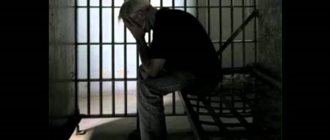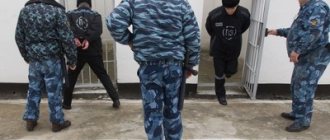What horrors did the last criminal executed in Russia, the maniac Sergei Golovkin, commit, Express Gazeta tells
Subscribe and read Express Newspaper in:
In May 1996, former Russian President Boris Yeltsin issued a decree “On the gradual reduction of the use of the death penalty in connection with Russia’s entry into the Council of Europe.” In a short time, hundreds of death row inmates’ requests for clemency were reviewed and granted. But not all of them: the most brutal murderers and criminals were denied life – among them was the maniac Sergei Golovkin, nicknamed “Fisher” or “Boa Constrictor.” He also became the last person executed in Russia* - the sentence was carried out on August 2, 1996. For what atrocities was Golovkin sentenced to death?
Moratorium on the death penalty
The last death sentence in Russia was carried out just a couple of weeks before it was abolished. To become familiar with this topic, you must refer to the Constitution of the Russian Federation and the Criminal Code. The death penalty is the highest degree of punishment that was imposed on persons who committed terrible crimes or attempted murder.
At the moment, the death penalty is prohibited by the following document: protocol number 6 and PACE recommendations. This type of punishment is legally prohibited.
Proponents of capital punishment in other countries
On November 20, 2015, after a series of terrorist attacks in Paris, the founder of the far-right National Front party, Jean-Marie Le Pen
proposed reinstating the death penalty in France. “We must consolidate the basic principles of self-defense and national priorities, restore the death penalty for terrorists, cut off their heads, as the Islamic State (a terrorist organization banned in the Russian Federation) does,” he said during his press conference.
On June 8 of the same year, after a series of terrorist attacks in Aktobe, President of Kazakhstan Nursultan Nazarbayev made a video message .
In it, the president also stated the need to return the death penalty: “Whoever takes up arms and kills a person should be sentenced to death.” The president's proposal was supported by a number of judges and deputies.
On July 21, in an interview with Al Jazeera, Turkish President Recep Tayyip Erdogan
said the country would reintroduce the death penalty “if people vote for it.” This statement was preceded by an attempted military coup in Turkey on the night of July 16. The EU authorities, in turn, said that if the death penalty is returned, they will stop negotiations on Turkey’s accession to the EU.
In May 2016, Philippine President Rodrigo Duterte
promised to bring back the death penalty, which was abolished in 2006. “I believe in retribution. You must pay. When you kill someone or rape someone, you must die,” he said. In March 2017, the country's parliament adopted a bill introducing the death penalty, but it did not receive the required number of votes.
In July 2022, Sri Lankan President Maithripala Sirisena
said the country would resume capital punishment for drug crimes despite a 40-year moratorium: “No matter what objections are raised, the necessary measures will be taken to carry out the death sentence against drug traffickers.”
In August 2022, in response to armed attacks on people in Dayton and El Paso, US President Donald Trump
advocated the introduction of the death penalty for mass murders motivated by hatred. He also spoke out in favor of introducing the death penalty for drug dealers found selling large quantities of drugs.
Denis Levinsky, Mikhail Malaev
Photo gallery
Reasons for abandoning the death penalty
This type of punishment is not available for two reasons:
- signed protocol No. 6 (European Convention for the Protection of Human Rights);
- presidential decree not allowing the death penalty.
Regarding the first point, the text states that it is impossible to take the life of a person intentionally, with the exception of imposing a death sentence. That is, by and large, the European Convention allows the death penalty. But, due to a presidential decree, it remains unavailable. This document prohibits the death penalty until a jury trial is created in all regions of the Russian Federation. The last death sentence in Russia was imposed shortly before the introduction of the moratorium (April 1997), which expired in January 2010. But in 2009 it was extended until the ratification of the protocol on the abolition of this punishment.
The history of the lethal measure of restraint
Talion’s principle of retaliation “an eye for an eye, a tooth for a tooth” is the first semblance of a law on lethal restraint for a person. According to this principle, retribution must be carried out in accordance with the crime.
This is a crude expression of justice, according to which the person who committed the murder must himself be killed, and in the same way. This trend has many branches depending on the state. For example, in Russian legislation, a semblance of such a principle existed in the Council Code until 1649.
In the post-war period, the tendency to abolish this preventive measure actively began to spread. The main role in this trend was played by the norms of the Universal Declaration of Human Rights, which came into force in 1948. Where it is said that each of the representatives of the human race has a legal right to life and no one else has the right to encroach on it.
By 2008, 135 out of 197 states abandoned this type of execution, replacing it with life imprisonment without the possibility of parole.
This video will show the defendants' reactions to the judge's sentencing of their death penalty:
Review of the type of punishment after the lifting of the moratorium
The last death sentence in Russia was carried out in 1996. But what happens if the moratorium is lifted? Prisoners are not required, but have the right, to file a petition for clemency. This is completely independent of whether this document was submitted before the moratorium was introduced or not.
The death sentence can be carried out in three cases:
- after the court verdict comes into force;
- rejection of the application by the President of the Russian Federation;
- non-application of pardon if the convicted person does not apply.
It is also necessary to know that new laws can either soften or worsen a prisoner’s sentence.
The last death penalty in Russia
The last death sentence in Russia (September 2, 1996) was handed down and carried out in Butyrka to Sergei Golovkin. This citizen committed about 40 particularly serious crimes (rape and murder of boys in the Moscow region). He carried on his criminal activities for 6 years. Two days before the capture of “Boa”, the Rostov court pronounced a verdict on the most terrible and dangerous criminal of the USSR, Andrei Chikatilo.
Since similar crimes were carried out in two regions at once (Moscow and the Rostov region), employees of the USSR criminal investigation department were inclined to this version: the crimes were committed by one person who made flights between these two regions. Before the capture of "Boa", the criminal was known under the nickname "Fisher".
Russian justice in a Western noose: Russia itself must decide who to execute and who to pardon
On August 2, 1996, the last death sentence in our post-Soviet history was carried out in the Moscow Butyrka prison. Serial killer, rapist and cannibal Sergei Golovkin, nicknamed Fisher. In the same year, Russia was invited to the Council of Europe, but with a categorical condition: to abolish the death penalty. Our country has signed Protocol No. 6 to the Human Rights Convention, although it has never ratified it. However, according to the Vienna Convention, it is still obliged to comply with it. Since then, people have not been shot in Russia. No one. And no way.
In 2022, the Public Opinion Foundation conducted a large-scale sociological study on the attitude of Russian residents towards the return of the death penalty. The results turned out to be predictable: 69% of respondents consider the death penalty for some criminals acceptable, 21% - unacceptable in principle, and 9% found it difficult to answer. Of the crimes for which it is proposed to punish by death, the top three look like this: sexual crime against minors (68%); murder (57%); terrorism (53%).
To be fair, it should be admitted that the number of supporters of the death penalty has decreased from 2001 to the present day (at that time, according to the FOM, 80% were in favor). But does this mean that our society has since become more humane and life safer? Hardly. Usually, as arguments in favor of maintaining the moratorium, its defenders cite the following arguments: human life is inviolable, no one has the right to deprive him of it; life imprisonment is a more severe punishment; Miscarriages of justice and execution of innocents are possible. Well, let's look at how valid they are.
“Human life is inviolable, no one has the right to deprive him of it”
As you know, after the Baptism of Rus', Prince Vladimir was so imbued with the Christian spirit of mercy that he abolished the death penalty in his domains. After which the number of murders increased many times over, and the Orthodox priests who arrived with him from Chersonesus themselves begged him to return this “highest measure,” for the prince’s duty is to restrain spontaneous and unlimited violence by measured and legalized violence.
This historical example reflects the only reasonable position that meets the public interests: the death penalty is allowed, but only as the “supreme measure of social protection” - that is, an extreme measure aimed not at taking revenge on the principle of “an eye for an eye”, but to rid society of danger in the person of this irredeemable personality.
Let's imagine that a rabid wolf came into the village. He hasn't bitten anyone yet. Or even bitten (“but it’s not his fault, he’s sick!”). And someone shot him. From the point of view of various crazy environmentalists, this is called “unjustified cruelty”. But from the point of view of the residents of this village, a shot that saved them and their children from mortal danger is the highest manifestation of humanism and philanthropy. So, if we talk about the “inhumanity” of the death penalty, it depends on whose side you look at it.
“Life imprisonment is a more severe punishment”?
We are told: life imprisonment is a much more severe punishment, because a person lives knowing that he will never be released again. Maybe so, but, as they say, “there are nuances.”
Firstly, it’s not a fact that “it will never work out”: there are corrupt judges, bought witnesses, changing articles and amnesties, and you never know what else! When the February Revolution occurred in Russia, all prisons were open, because, by definition, “victims of the tsarist regime” were kept there. And such animals were released into the wild that then for ten years they were caught all over the country and put against the wall.
What about 1917! In the early 1990s, when “free Ichkeria” emerged from the Chechen-Ingush Autonomous Soviet Socialist Republic, Dudayev, in search of support, released from all prisons more than 2,500 bandyugans who were serving the most serious charges, who (as well as their numerous relatives) became the main “guard” of the regime - Russians were slaughtered by the thousands and expelled by the hundreds of thousands. Thus, thoughtless “humanism” resulted in many times more victims of innocent people. Which would not have happened if the trial had been less “humane” and those animals in human form had been more quickly sent immediately “to Allah for judgment.”
And secondly (and most importantly), the monsters sentenced to life imprisonment are kept in special detention centers where they do not work. This means that all expenses for their stay and maintenance there are borne by taxpayers. That is, including the families of those they killed. If this is called “justice”, then what is “injustice”?!
“Miscarriages of justice and execution of innocents are possible”
This is the only logical argument of all those cited by opponents of the death penalty. Moreover, the point is not so much in judicial errors, which are always isolated, but in the fact that with the current level of corruption in the investigative and judicial system, “custom” cases with imprisonments under serious charges have become almost an everyday reality. As well as salvation from the deserved punishment of notorious murderers and non-humans.
For example, a little over a month ago, six unemployed (and at the trial completely forgot the Russian language) drunken Tajiks brutally beat and then drowned athlete Sergei Chuev, who stood up for a pregnant woman, in a nearby pond, at the same time beating his wife. After the double intervention of the Embassy of Tajikistan and the Tajik diaspora, the court “showed humanity” by sentencing the obvious killers - one to 7 years, the other to 4.5 years, and four to 4 years of imprisonment in a general (!) regime zone. Taking into account the year spent in the pre-trial detention center, these non-humans have a chance to be released on parole next year.
At the same time, another court, examining the case of unintentional murder from “trauma” by the Russian guy Anatoly Grudistov, who was fighting off a crowd of brutal Azerbaijanis, one of the attackers, gave him 12 years of strict (!) regime. Of course, also not without the participation of unknown patrons from the diaspora.
There are a lot of examples of such “false” cases on a domestic, commercial and even political basis. But does this mean that the death penalty in cases where guilt has been proven beyond doubt should not be returned? In no case! After all, the poor state of current, more than once “optimized” medicine is not a reason not to treat people at all. This is entirely consistent with the position of the Church, which, remembering the biblical “thou shalt not kill,” is very cautious about the return of the death penalty. Patriarch Kirill formulated his position as follows:
I am against the death penalty in modern Russia... Given the current state of our courts, if there is a death penalty, people will be “removed” by law... Therefore, if we talk about returning to the death penalty in some very specific cases, when we are talking about maniacs, massacres, terrorists. At the same time, of course, it is absolutely clear: you need to have evidence that this person really was one.
Apparently, this position is the most correct and adequate to reality today. Don’t shoot left and right, but in undeniable cases, rid society of irredeemable non-humans. Mistakes in this case, of course, are possible, but this only means that the punishment for these mistakes, and even more so for the malicious “cooking” of cases, must be adequate to the sentences passed unjustly.
So what?
They have repeatedly demanded the return of the death penalty. In particular, in 2019, Sergei Mironov introduced a bill to the State Duma to lift the moratorium on terrorists and child killers. But it was not supported due to the “impossibility of violating international obligations” (before the adoption of the latest amendments, the Constitution contained the categorical primacy of international legislation and agreements over national legislation). Many lawyers were categorically against it. “It is possible to cancel an unjust sentence even after 25 years... But if the death penalty is applied, this becomes impossible,” Sergei Nasonov, adviser to the Federal Chamber of Lawyers, justified their position.
Somewhat earlier, after the terrorist attack in 2022 in the St. Petersburg metro (14 people were killed, 50 were injured), the speaker of the St. Petersburg parliament, Vyacheslav Makarov, demanded the return of the death penalty. And two years earlier, the head of the Russian Investigative Committee, Alexander Bastrykin, at an event in memory of a 13-year-old boy who died while protecting his sister from a pedophile, said that
people who commit such serious crimes have no place on earth... If you took someone else’s life, especially the life of a child, you will pay with your own.
They were not heard either: “international obligations” and membership in the Council of Europe seemed to some to be much more significant than the lives of their own citizens.
This dispute continues to this day. But one thing is indisputable: the “humanization” of our legislation that took place in 1996 has not made the world around us any kinder. And at the same time, none of the most terrible murderers, child rapists, terrorists, who are responsible for a lot of victims, were destroyed. Even with a delay of a year or more, allowing lawyers to find new facts and challenge the court’s decision. For the death penalty is essentially the last opportunity of the state to protect society from those who pose a mortal danger to it. Even if it is postponed for a year, for several years: sitting in a cell, knowing that no one will touch you and that they will feed you at public expense, and sitting waiting for a well-deserved bullet - these, believe me, are “two big differences.”
Yes, since mid-1996, humane deputies, lawyers and human rights activists have saved many criminals from death with their position, among whom there may have been innocent people. But on the other side of the scale are the many times larger number of lives of completely innocent people who died because, thanks to this “humanism,” many animals in human form not only survived, but were eventually released. And a hundred times greater number of scum predisposed to murder, without a deterrent in the form of a threat to their precious life, without hesitation, used weapons, killing good people, depriving families, orphaning children. All this is also on the conscience of the “humanists”, and they will have to answer for it - if not on earth, then at the Heavenly Court, where excuses like “we wanted the best” are not accepted in principle.
Role-playing game
The last death sentence in Russia was handed down on September 2, 1996, to the particularly dangerous serial killer and rapist Sergei Golovkin. The most terrible thing about these crimes was that Boa constricted himself as a fascist and his victim as a partisan. For Golovkin, murder and torture are a kind of role-playing game.
He committed his first crime in 1982 near the Romantic camp. Golovkin tracked down the boy and, under threat of death, took him into the forest. There he tore off the child's clothes and hung him from a tree using a rope loop. Fortunately, this time the victim remained alive and was able to describe the appearance of the criminal.
The political officer of the Kamchatka pre-trial detention center says:
0
See all photos in the gallery
Firstly, such a sacrament was performed only in those prison casemates that were designated by the Ministry of Internal Affairs for each Russian region. When a death row prisoner held by us was denied pardon, an encrypted message came from Moscow with this news and an instruction: in order to execute the sentence against the convicted person, we must immediately transport him by special escort to the Khabarovsk pre-trial detention center to carry out the sentence. I was always amazed at how quickly my colleagues there sent a person whom I had literally just handed over to the convoy to another world - it turned out that he was put against the wall in the very first hours after meeting him. As they say, hello and goodbye.
And another thing: the rules for keeping death row prisoners, their preparation for execution and its ritual itself were declared top secret order of the USSR Ministry of Internal Affairs No. 002 - my then boss kept it in a personal safe and only waved the cover in front of my nose once. No matter how many secrets we have learned from the special services over the past decade, the execution topic still remains tightly closed to society; those conversations with executors that claim to be sensational, which often appear in the newspapers, are nothing more than the fantasies of my colleagues in the pen.
×
0
As soon as the court announces a death sentence to the criminal, immediately after returning to the pre-trial detention center, he is dressed in a striped robe with a striped cap and placed in a special cell. The barred window in it is covered with such a thick visor that one can only guess about the heavens on the other side. The door is locked with a combination lock, which cannot be opened without the knowledge of the assistant director of the pre-trial detention center on duty. Those sentenced to death while away their days either alone or with a partner. Every day begins with handcuffing and a general search - walls and bars are tapped, bedding and clothes are probed centimeter by centimeter. No walks, no dates, no conversations on the phone, which are occasionally allowed to others. Exit to the bathhouse or to the medical unit - only one by one, only in handcuffs and with heavy security, only through deserted corridors. In the first months after the verdict, death row inmates live in hope - after all, the cassation appeal to the Supreme Court has gone, what if the verdict is either canceled, or the case is sent for further investigation, or the “tower” is replaced with life? This wait can last six months, or even more, all this time the person does not leave hope for a better outcome. From time to time, the only person on the outside with whom it is allowed to communicate appears - his lawyer, who will console him and share news.
0
But now the decision of the Supreme Court has been received, the verdict has been confirmed, but the death row man is still holding on - it’s not evening yet! You can also compose and send a pitiful petition to the president and expect mercy from him. They wait a year, a year and a half - I still remember the double murderer Marat Konkin, who was tortured in anticipation of execution for four years and was still allowed to live. It was no longer a person—a lying corpse. Gray hair on his balding head, shaking hands, dystrophic thinness - he was then twenty-four years old. And one more trick that perhaps few people know about. Death row inmates learn the result of considering a petition for clemency only if it is granted and the person is given life. If I opened a secret package with a refusal delivered by the field communications service, on the same day and hour we received an order: to send the condemned person to Khabarovsk on the next plane flight. What this meant was known not only to us officers, but also to those passengers who were being taken to slaughter.
0
An old truth: everything that they try to hide is shrouded in more than just secrecy - lies. The suicide bombers begged to meet with their wife, mother or child - we lied to them that they either had a cold, or a blizzard blocked all the roads, or the post office and telephone were working very poorly. If only he would believe us, if only he wouldn’t freak out and get on our nerves by opening veins or making a noose. Once they read to us a menacing order from the minister, by which the shoulder straps of the leaders of one of the “execution” pre-trial detention centers were torn off: one of their suicide bombers did commit suicide. Between the lines one could easily recognize not only the minister’s anger, but also simply a personal insult to him: the bandit should have been shot by the will of the court and the president, but he, the impudent one, arbitrarily took his own life and escaped from legal punishment. Seeing off those condemned to execution, in which I took part in my accursed position, now seems to me like a solid theatrical performance, in which both the main characters and the extras played their roles naturally. Imagine - absolutely all the suicide bombers believed us.
0
So, a special convoy arrived - four hefty guys with machine guns, walkie-talkies and a dog. Today they will take Kostya Ivantsov, 26 years old, on his last journey, always known as an excellent worker at the shipyard and an exemplary family man. And here you are: I went fishing with my friends, they started poaching, and then a fisheries inspector showed up. Kostya was drunk to the point of amazement at the time, and therefore he ended the squabble with the unexpected guest as easily as possible: he hit him with a doublet from a gun... I talked with Kostya more often than with others, no matter how hard I tried to pass unnoticed near his cell - he heard and recognized my steps. I noticed this amazing ability in every suicide bomber: God knows how, but they unmistakably guessed who was passing along the corridor - the owner, godfather or lepila (doctor). I will not hide that talking with the doomed was a mortal torment for me, especially in the evenings, when I felt that my reserve of compassion had already been spent, that I could no longer listen, or smile, or speak. And then watch your face, gait, movements, speech and think about what smile to squeeze out of yourself when the same Kostya asked the same thing: “Boss, will they kill me soon?”
0
But that's it now. Now I come to Ivantsov exactly after dinner and play my role diligently: they say, his pardon will not be considered until another examination is carried out, this time in Khabarovsk. So, grab your things and head out. You'll take a ride, they say, at our expense on a good plane, rest for two or three weeks in a hospital bed and come back. And at that very second I see in front of me a robot, a mannequin: the face is white, motionless, the movements are slow but precise. He puts his simple belongings into a bundle, but cannot tie the ribbons: his hands do not obey. Not a single question, not a single request - guessed it? The sergeants and the duty officer who are waiting for us in the corridor, the convoy, to whom after eighty-five steps (counted!) they will hand over Ivantsov - sheer cordiality, sheer courtesy. Walk, Kostya, through the bars, through the heavy doors, get into a paddy wagon specially provided for you, fly on a plane with nice flight attendants and cheerful passengers - this is your last journey, at the end of which - a bullet in the back of the head. Neither farewell to relatives, nor confession with communion, nor the last letter - the acting in which we participate does not provide for such excesses.
Witness
Boa Constrictor, who received the last death sentence in Russia, committed the following crimes with greater cruelty. The second victim is a teenager from the Zvezdny camp in the Odintsovo district. He cut off the boy's head and ripped open the abdominal cavity; the severed genitals were found next to the body in a bag.
The third victim was dismembered in the village of Zarechye. The crime was committed with great cruelty, because more than 30 stab wounds were found on the remains of the dismembered body.
After three cases, the Odintsovo district police department created an investigative and operational group to capture Golovkin, because it became clear that a serial, especially dangerous criminal had appeared in the city. That’s how they found the first witness in the pioneer camp “Zvezdny”, he claimed that he saw a Boa constrictor, and he said his last name.
Who spoke out for the return of executions to the Russian Federation
In February 2013, the head of the Ministry of Internal Affairs Vladimir Kolokoltsev
commented on the murder of two girls in Tatarstan and the Irkutsk region:
I believe that the death penalty in such cases is a normal reaction of society to a fait accompli.
In April 2013, during a direct line, President Vladimir Putin
commented on the massacre in Belgorod:
You know, when sometimes you come across such things, your hand naturally reaches for a fountain pen to sign some documents aimed at returning the death penalty, or to ask deputies about it.
In 2016, the leader of A Just Russia, Sergei Mironov
, as well as deputies Mikhail Emelyanov and Oleg Nilov, introduced a bill to the State Duma that would introduce the death penalty for terrorism.
In June 2022, after the terrorist attack in the St. Petersburg metro, the chairman of the State Duma Committee on Security Vasily Piskarev
proposed to impose a suspended death penalty on terrorists: to indicate it in court sentences, but not to apply it, but to give life imprisonment. According to the deputy, this will make it possible to give a legal assessment of the most serious crimes.
In October 2022, in connection with the murder of a nine-year-old girl in Saratov, Mr. Mironov, the leader of the Communist Party of the Russian Federation Gennady Zyuganov, State Duma deputies Evgeny Primakov (United Russia) and Olga Alimova (Communist Party of the Russian Federation)
advocated a partial lifting of the moratorium on the death penalty.
“If the death penalty punished pedophiles, murderers, rapists, terrorists, then grief would not come to our homes. We’ve been playing with democracy and tolerance,” Ms. Alimova wrote on her Instagram page.
In October of the same year, on the State Duma page on VKontakte
a survey was published on the topic: “Do you think the death penalty should be restored for child killers and pedophiles?” At the moment, more than 160 thousand people took part in it: 78% voted for lifting the moratorium, 18% voted against. Another 4% of social network users chose the “other” option.
In May 2022, after a shooting at a Kazan gymnasium, during which nine people were killed, the leader of A Just Russia, Sergei Mironov
again called for the return of the death penalty for the murder of children.
Fisher version
The last death sentence in Russia was carried out in 1996, the defendant's name was Sergei Golovkin. After committing three crimes, he “lay low” for several years. But this break was only the “calm before the storm.”
We have already mentioned that a witness was found in the Zvezdny camp. So, this boy, unlike his friend, was able to escape from the criminal. He said that they talked to him not far from the camp. Golovkin said that his last name is Fischer, he escaped from prison and the police are looking for him. The boy described his appearance and the tattoo he saw on his arm.
Thus, police officers were able to identify about 6 thousand people prone to violence and solve some crimes. But Golovkin remained free.
Childhood of a maniac
Sergei Golovkin was born in 1959, into a dysfunctional Moscow family. The father is an alcoholic who, according to some reports, molested his own child. Information about the mother is vague: some sources present the woman as quiet and downtrodden, others partly blame her for the broken psyche of a cruel maniac: they say that Golovkina often raised her voice at her son and beat him.
Sergei grew up as a physically weak boy: born with a chest deformation, he often caught colds and was sick, and also suffered from enuresis. Classmates - including the leader of the rock group "Crematorium" Armen Grigoryan - remembered Golovkin as a reserved, unremarkable guy: he studied with "B" and "F" grades, studied in sections, but without much success, and preferred solitude. By the end of school he had grown and become stronger, but he was still not interested in girls. The indifference to the opposite sex was mutual: the young man’s appearance was spoiled by acne and stooped posture.
Golovkin showed sadistic tendencies even as a child: at 13, he tortured a cat and mocked fish by lowering a boiler into an aquarium. And after the incident at the university, the tendencies of a maniac were completely formed in Sergei. The following happened: a group of teenage hooligans attacked him, a senior student at the Timiryazev Academy, and severely beat him. Later, the already detained killer admitted: thinking about revenge, he more than once excitedly imagined thin, dark-haired boys no older than 15 years old - these were his future unfortunate victims.
Maniac Sergei Golovkin. Still from the Crime TV video
Handwriting
The last time a death sentence was carried out in Russia was a few weeks before the abolition of the death penalty on the territory of the state.
During the “lull”, Fischer purchased a car and received a place for a garage on the territory of the Moscow stud farm, where he worked as a livestock specialist. Beneath it he set up a place of torture for his future victims.
This is how the criminal’s style changed, he lured people into his garage under various pretexts or picked up teenagers voting on the road. After the torture, Golovkin took the bodies to the “burial grounds.”
Strengthening the task force
The last death sentence in Russia was carried out on September 2, 1996. But how was the criminal caught? After strengthening the task force, another terrible crime occurred. On September 15, 1992, three boys disappeared at once.
The operatives managed to find out that Uncle Seryozha, who works at the Moscow Stud Farm No. 1, once gave them a lift in his new car. Then the employees had no doubts. We need to catch the criminal, and urgently, before other children die in the “clutches” of a serial killer.
Boa Constrictor Detention
How to make an arrest if there is no evidence? Even round-the-clock monitoring of the maniac did not produce any results.
I had to take it under Article 90 (10/19/92). Only after inspecting the garage was he charged under Art. 102 (October 30 of the same year). Golovkin indicated all the burial places; some of the people were still listed as “missing” at that time. Golovkin admitted to killing only eleven children, which did not prevent him from being sentenced to the highest degree of punishment. The investigation continued until 1994, but it was not possible to prove the involvement of Boa in other crimes.
Puff
The last death sentence in Russia regarding Golovkin was carried out in 1996, and the court's decision was heard back in 1994. Why was the sentence not carried out earlier?
Boris Yeltsin ignored the petitions for a long time, but on the eve of the signing of Protocol No. 6, all complaints (more than 100) were urgently considered. More than half were rejected, and Golovkin’s petition was also included here. For the rest, the death penalty was replaced with life or 25-year imprisonment.







